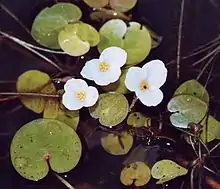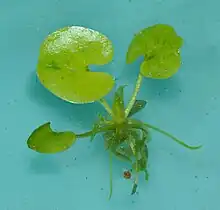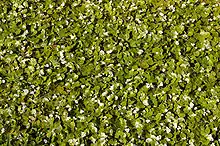| Hydrocharis morsus-ranae | |
|---|---|
 | |
| Scientific classification | |
| Kingdom: | Plantae |
| Clade: | Tracheophytes |
| Clade: | Angiosperms |
| Clade: | Monocots |
| Order: | Alismatales |
| Family: | Hydrocharitaceae |
| Genus: | Hydrocharis |
| Species: | H. morsus-ranae |
| Binomial name | |
| Hydrocharis morsus-ranae | |

Hydrocharis morsus-ranae L. is a species of the genus Hydrocharis known by the common name European frog-bit. It is a free-floating flowering plant that bears small white flowers. "Morsus-ranae" means "frog bite" in Latin, and it is part of this species' scientific name because frogs might seen as biting on the leaves.[1] European frog-bit is often mistaken for an American frog-bit (Limnobium spongia) due to their similar looks and floating freely.[2] It usually displays invasive behavior in Canada and North America, having a major impact on native ecosystems. However, European frog-bit is efficient in accumulating high concentrations of heavy metals and chemicals, removing waste from water.[3]
Description
Hydrocharis morsus-ranae L is a perennial plant with a stoloniferous growth, reaching a diameter of 0.1 to 1.5 meters. It forms individual rosettes ranging from 1 to 30 cm. While mainly having separate male and female plants, it sometimes shows both sexes on different shoots within a group of plants (genet) rather than within the same rosette[1]. The plant has unbranched white roots that extend up to 50 cm and have numerous extended root hairs. The circular floating leaves display visible aerenchyma on the undersurface. The slender petioles, 6–14 cm, have two free lateral stipules at the base[2].

Frogbit is native to Europe and parts of Asia, but it was introduced to Canada in the 1930s and has become invasive in eastern Canada and the northeastern United States, particularly around the Great Lakes. It is considered a pest in this region as it colonises waterways and forms dense masses of vegetation on the surface, threatening native biodiversity, although in its native areas it is rarely dominant.
References
- 1 2 Catling, P. M.; Mitrow, G.; Haber, E.; Posluszny, U.; Charlton, W. A. (2003-10-01). "The biology of Canadian weeds. 124. Hydrocharis morsus-ranae L." Canadian Journal of Plant Science. 83 (4): 1001–1016. doi:10.4141/P02-033. ISSN 0008-4220.
- 1 2 Catling, P. M.; Dore, W. G. (1982). "Status and Identification of Hydrocharis Morsus-Ranae and Limnobium Spongia (hydrocharitaceae) in Northeastern North America". Rhodora. 84 (840): 523–545. ISSN 0035-4902.
- ↑ Polechońska, Ludmiła; Samecka-Cymerman, Aleksandra (February 2016). "Bioaccumulation of macro- and trace elements by European frogbit (Hydrocharis morsus-ranae L.) in relation to environmental pollution". Environmental Science and Pollution Research. 23 (4): 3469–3480. doi:10.1007/s11356-015-5550-z. ISSN 0944-1344.
External links
